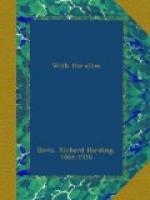This was at a point four kilometres from Chaudun, between the villages of Breuil and Courtelles. From this height you could see almost to Compiegne, and thirty miles in front in the direction of Saint-Quentin. It was a panorama of wooded hills, gray villages in fields of yellow grain, miles of poplars marking the roads, and below us the flashing waters of the Aisne and the canal, with at our feet the steeples of the cathedral of Soissons and the gate to the old abbey of Thomas a Becket. Across these steeples the shells sang, and on both sides of the Aisne Valley the artillery was engaged. The wind was blowing forty knots, which prevented the use of the French aeroplanes, but it cleared the air, and, helped by brilliant sunshine, it was possible to follow the smoke of the battle for fifteen miles. The wind was blowing toward our right, where we were told were the English, and though as their shrapnel burst we could see the flash of guns and rings of smoke, the report of the guns did not reach us. It gave the curious impression of a bombardment conducted in utter silence.
From our left the wind carried the sounds clearly. The jar and roar of the cannon were insistent, and on both sides of the valley the hilltops were wrapped with white clouds. Back of us in the wheat-fields shells were setting fire to the giant haystacks and piles of grain, which in the clear sunshine burned a blatant red. At times shells would strike in the villages of Breuil and Vauxbain, and houses would burst into flames, the gale fanning the fire to great height and hiding the village in smoke. Some three hundred yards ahead of us the shells of German siege-guns were trying to destroy the road, which the poplars clearly betrayed. But their practice was at fault, and the shells fell only on either side. When they struck they burst with a roar, casting up black fumes and digging a grave twenty yards in circumference.
But the French soldiers disregarded them entirely. In the trenches which the Germans had made and abandoned they hid from the wind and slept peacefully. Others slept in the lee of the haystacks, their red breeches and blue coats making wonderful splashes of color against the yellow grain. For seven days these same men had been fighting without pause, and battles bore them.
Late in the afternoon, all along the fifteen miles of battle, firing ceased, for the Germans were falling back, and once more Soissons, freed of them as fifteen hundred years ago she had freed herself of the Romans, held out her arms to the Allies.
Chapter VI The Bombardment of Rheims
In several ways the city of Rheims is celebrated. Some know her only through her cathedral, where were crowned all but six of the kings of France, and where the stained-glass windows, with those in the cathedrals of Chartres and Burgos, Spain, are the most beautiful in all the world. Children know Rheims through the wicked magpie which the archbishop excommunicated, and to their elders, if they are rich, Rheims is the place from which comes all their champagne.




